Related Research Articles

Mount Kinabalu is the highest mountain in Borneo and Malaysia. With an elevation of 4,095 metres (13,435 ft), it is third-highest peak of an island on Earth, and 20th most prominent mountain in the world. The mountain is located in Ranau district, West Coast Division of Sabah, Malaysia. It is protected as Kinabalu Park, a World Heritage Site.

Nepenthes rajah is a carnivorous pitcher plant species of the family Nepenthaceae. It is endemic to Mount Kinabalu and neighbouring Mount Tambuyukon in Sabah, Malaysian Borneo. Nepenthes rajah grows exclusively on serpentine substrates, particularly in areas of seeping ground water where the soil is loose and permanently moist. The species has an altitudinal range of 1,500–2,650 metres (4,920–8,690 ft) a.s.l. and is thus considered a highland or sub-alpine plant. Due to its localised distribution, N. rajah is classified as an endangered species by the IUCN and listed on CITES Appendix I.

Mount Tambuyukon or Tamboyukon is a mountain located at the West Coast and Kudat divisions of Sabah, Malaysia. It is considered the third-highest mountain in the country with height at 2,579 metres (8,461 ft), lying north of the highest Mount Kinabalu.
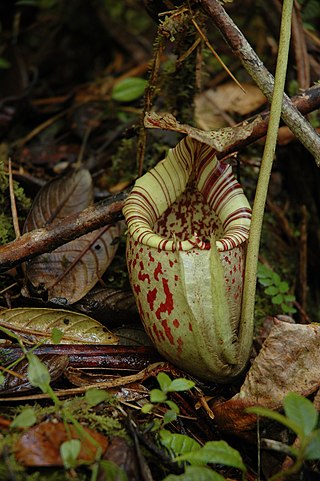
Nepenthes burbidgeae, also known as the painted pitcher plant or Burbidge's Pitcher-Plant, is a tropical pitcher plant with a patchy distribution around Mount Kinabalu and neighbouring Mount Tambuyukon in Sabah, Borneo.

Nepenthes reinwardtiana is a tropical pitcher plant native to Borneo and Sumatra and to a number of smaller surrounding islands including Bangka, Natuna, Nias, and Siberut. Although some sources have included Peninsular Malaysia and Singapore within the range of this species, these records appear to be erroneous.
Datuk Anthony L. Lamb, P.G.D.K. was a British botanist, born in British Ceylon who specialised in the flora of Sabah, East Malaysia, on the northwest portion of the island of Borneo.
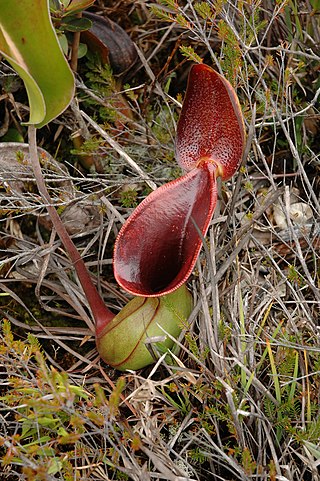
Nepenthes lowii, or Low's pitcher-plant, is a tropical pitcher plant endemic to Borneo. It is named after Hugh Low, who discovered it on Mount Kinabalu. This species is perhaps the most unusual in the genus, being characterised by its strongly constricted upper pitchers, which bear a greatly reduced peristome and a reflexed lid with numerous bristles on its lower surface.

Nepenthes fusca, or the dusky pitcher-plant, is a tropical pitcher plant endemic to Borneo. It is found throughout a wide altitudinal range and is almost always epiphytic in nature, primarily growing in mossy forest.
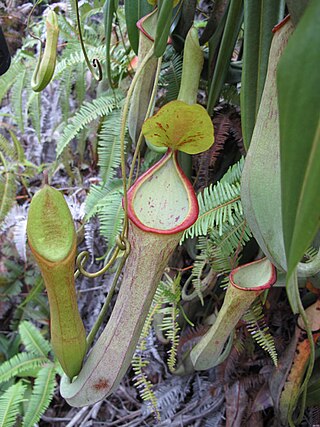
Nepenthes macrovulgaris, or the serpentine pitcher-plant, is a tropical pitcher plant endemic to Borneo. It is a lowland plant that typically grows at altitudes ranging from 300 to 1200 m in sub-montane forest clearings and mossy forest. Its range is restricted to ultramafic habitats, including Mount Kinabalu, Mount Tambuyukon, the Danum Valley, the Tawai Range, the Meliau Range and Mount Silam, all in Sabah, Malaysian Borneo. Pitchers grow to around 25 cm high and range in colour from green to brown, with the speckled form being the most common.

Nepenthes stenophylla, or the narrow-leaved pitcher-plant, is a tropical pitcher plant endemic to Borneo. The species produces attractive funnel-shaped pitchers up to 25 cm high. It is listed as Least Concern on the IUCN Red List. Nepenthes stenophylla belongs to the loosely defined "N. maxima complex", which also includes, among other species, N. boschiana, N. chaniana, N. epiphytica, N. eymae, N. faizaliana, N. fusca, N. klossii, N. maxima, N. platychila, and N. vogelii.
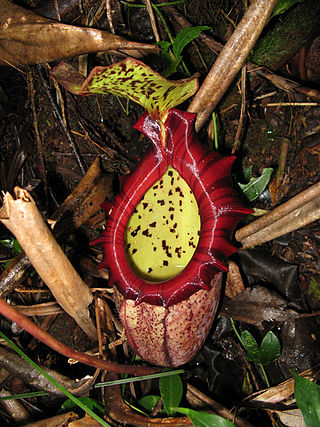
Nepenthes × alisaputrana, or the leopard pitcher-plant, is a hybrid of two well-known Nepenthes pitcher plant species: N. burbidgeae and N. rajah. The plant is confined to Mount Kinabalu in Sabah, Borneo.

Nepenthes pilosa is a tropical pitcher plant endemic to Borneo. It is characterised by a dense indumentum of long yellow-brown hairs. Pitchers have a distinctive hook-shaped appendage on the underside of the lid. The specific epithet derives from the Latin word pilosus, meaning "hairy".

Mesilau, named after Mesilau River, is an area situated at approximately 2,000 m (6,562 ft) above sea level on the East Ridge of Mount Kinabalu in Kinabalu National Park, Sabah, Malaysian Borneo. It is the site of the Mesilau Nature Resort, which is owned and operated by Sutera Sanctuary Lodges.
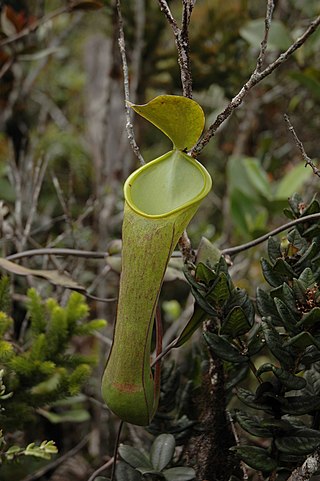
Nepenthes murudensis, or the Murud pitcher-plant, is a tropical pitcher plant endemic to Mount Murud in Borneo, after which it is named. It is of putative hybrid origin: its two original parent species are thought to be N. reinwardtiana and N. tentaculata.
Mount Trusmadi or Trus Madi is a mountain located at the Interior Division of Sabah, Malaysia. It is considered as the second highest mountain in both Sabah and Malaysia at 2,642 metres (8,668 ft), after Mount Kinabalu with Trusmadi offering a tougher climbing challenge than the latter.

Pitcher-Plants of Borneo is a monograph by Anthea Phillipps and Anthony Lamb on the tropical pitcher plants of Borneo. It was first published in 1996 by Natural History Publications (Borneo), in association with the Royal Botanic Gardens, Kew and the Malaysian Nature Society. An updated and much expanded second edition was published in 2008 as Pitcher Plants of Borneo, with Ch'ien Lee as co-author.

Rhododendron crassifolium is a species of tropical rhododendron, a perennial flowering plant belonging to the family Ericaceae.

Rhododendron javanicum is a rhododendron species native to Indonesia, Malaysia, and the Philippines. This evergreen shrub grows to 5 m (16 ft) with bright orange flowers in spring. Plants may be terrestrial or epiphytic. Some forms from the Philippines may have red or bicoloured flowers, but are less often seen in cultivation.
Mount Magdalena is a volcanic cone mountain located at the Tawau Division of Sabah, Malaysia. It reaches a height of approximately 1,310 metres (4,298 ft).

Mount Silam is a mountain in Lahad Datu District, Sabah, Malaysia.
References
- ↑ Natural History Publications (Borneo) Sdn. Bhd. "Natural History Publications (Borneo) Author Biography". Archived from the original on 14 July 2011. Retrieved 24 November 2010.
- ↑ Payne, Junaidi; Francis, Charles M. (1985). A Field Guide to the Mammals of Borneo. Sabah Society. ISBN 978-967-99947-1-1.
- ↑ Parris, B. S.; Beaman, Reed S.; Beaman, John H.; Wood, Jeffrey J. (1992). The Plants of Mount Kinabalu: Gymnosperms and non-orchid monocotyledons. Royal Botanic Gardens, Kew. ISBN 978-983-812-026-5.
- ↑ "Conservation Fellows Datuk Anthony Lamb and Anthea Phillipps". Sukau Rainforest Lodge. 21 August 2017. Retrieved 31 May 2023.
- ↑ "Hornstedtia reticulata (K.Schum.) K.Schum". Royal Botanic Garden Edinburgh - Herbarium catalogue. Retrieved 31 May 2023.
- ↑ Sather, Clifford (1997). The Bajau Laut: Adaptation, History, and Fate in a Maritime Fishing Society of South-eastern Sabah. Oxford University Press. ISBN 978-983-56-0015-9.
- ↑ Malayan Naturalist. Malayan Nature Society. 1996.
- ↑ Obituaries, Telegraph (27 May 2019). "George Argent, botanist and veteran of hair-raising expeditions to the tropics who became a world expert on Vireya rhododendrons – obituary". The Telegraph. ISSN 0307-1235 . Retrieved 31 May 2023.
- ↑ Huisman, J (1993). "New species of Gunungiella (Trichoptera: Philopotamidae) from Sabah, East Malaysia" (PDF). Zoologische Mededeelingen. Rijksmuseum. 67: 75–89.
- ↑ International Plant Names Index. Phillipps.
- ↑ Society, Sabah (1974). Sabah Society Journal. Sabah Society.
- ↑ "Conservation Fellows Datuk Anthony Lamb and Anthea Phillipps". Sukau Rainforest Lodge. 21 August 2017. Retrieved 31 May 2023.